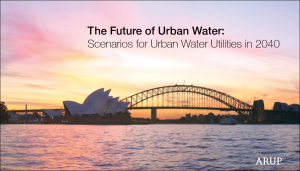Technology on tap: managing our water better
How water will be used and managed in Australia and globally in 2040.
Arup’s study, The Future of Urban Water, outlines four different scenarios for how water authorities will manage the resource and how consumers will access and pay for it.
Each is very different, with very different outcomes, but the one thing they all have in common is that technology will have a huge impact on the way we use and manage water, both for individual households and for water authorities.
While the study was undertaken in collaboration with Sydney Water* and considers how water will be used in 25 years’ time, it’s a good starting point to think about how all cities will manage their water resources in the future.
Challenges for water utilities in Australia include meeting future demand for water in a changing climate, managing diverse sources of supply, ensuring the health of waterways and ecological systems, maintaining the affordability of water services and reducing the carbon footprint of urban water supply and use. For urban water utilities, this means making innovation and investment decisions that maximise opportunities to provide services of value, while mitigating future risks and uncertainties.
Currently, most of us just turn on the tap for a drink or a shower without giving it a second thought. But as demand for water increases, with growth in city populations, one of the things that will help people manage their water usage is giving them more information about their water bills. This will save them money and help water authorities to reduce overall demand and so will also lower overall costs.
We’re moving to a point where technology in individual homes will enable people to have real-time understanding of their water use throughout the day.
They’ll be able to see how much water is used in each room of the house and at which times, possibly through a smart phone app. Households will also be able to identify water leaks that they don’t currently know they have, which cost both them and the water authorities money. They’ll also be able to see how their water usage will affect their bills.
One other change we may see in the future to help manage demand is for water authorities to consider moving to a point where they utilise the ability to undertake real time monitoring of household use to adopt changes to billing models. For example it would be possible to adopt similar peak and off-peak billing models to those that power companies use. This would enable water authorities to help influence changes in customer behaviour through pricing incentives.
Technology can help with this.
The information water authorities gain from households and from the wider water system can help them understand how they can minimise their energy costs, consider ways to automate systems and reduce overall operational expenditure. Real-time monitoring can also help them identify where leaks are in the network – reducing the amount of non-revenue water.
Each city will have different drivers and requirements for water use and running their water supply systems, so what works in Sydney will be slightly different to what’s required for Melbourne, Perth or Brisbane.
But these new technologies will help us learn from one another about how to better manage the water. Data from water supply systems and from individual households will give us a better understanding of consumer behaviour and the challenges around how to operate and maintain systems more effectively.
The rate of learning that we have is going to continue to accelerate and that has the potential to continue to fast-track the advancements that are occurring in the water industry.
Ultimately this will assist in delivering better value to the customer and more dividends to the owner.
* (While Arup conducted the study in conjunction with Sydney Water, all the views expressed here are Arup’s, and do not relate to the future of Sydney Water.)
The IWA World Water Congress in Brisbane will be an opportunity for City Leaders to sharpen their vision on sustainable urban water, and share their cities’ innovations and strategies to build resilience through the City Leaders Forum and the Cities Pavilion:
City Leaders Forum
Dates: 11 -12 October 2016, 10.30 – 17.00
Venue: Room 01, Brisbane Convention & Exhibition Centre
The City Leaders Forum provides a unique opportunity to bring together invited City Leaders (i.e.: sustainability managers, urban planning directors, city managers, and elected leaders) to share their water successes and challenges, while looking through the lens of the Principles for Water Wise Cities to identify the key success factors and bottlenecks to meeting locally the national goals that have been agreed to by governments around the world. On October 11th, the day will start with an Introduction to the IWA Principles for Water Wise Cities followed by their official launch at the Cities Pavilion, powered by Arup.
Cities Pavilion
Dates: 09 -14 October 2016, 10.30 – 17.00
Venue: Exhibition Hall, Brisbane Convention & Exhibition Centre
The Cities Pavilion will be an area for cities to highlight their innovations and leadership towards urban resilience and to network with other cities to become inspired by similar contexts and solutions.
For more information on Arup please see: http://www.arup.com/markets/water


